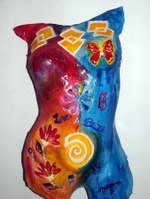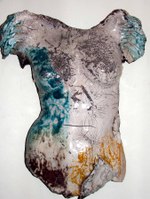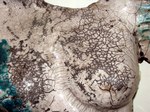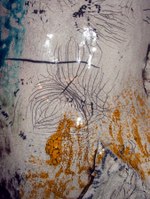 Slab-built torso, Retro, by Tammy Vitale of Tam’s Originals
Slab-built torso, Retro, by Tammy Vitale of Tam’s Originals
On raku….here is an excerpt from an email to Dhyana when I finished my latest firing:
The new crackle white CRACKLES!!!!!!! BIG time! [80% gerstley borate and 20% cornwall stone, Soldner’s crackle] Didn’t quite figure out the horsehair – I missed the "just right" – tried too hot and too cool – got some but not much for the amount I used – find you need maybe one piece at a time – I was being generous. This horse hair used correctly may last until the day we both day.
The white crackle – let it oxidize before putting it in the fire and the fire wasn’t all that hot because everything was so wet. Maybe that had something to do with the crackle but it is SPECTACULAR!!!
I put the orange commercial over the white crackle and it didn’t come out solid but in pieces and is bright yellow.
All in all a great firing both for what I learned and what I got. Is this not THE BEST?
Can you tell I was enthusiastic? And I just got in the latest cc of Gary Ferguson’s Just Raku newsletter in time to share with you his take on crackle (newsletter #40):
"I love a good crackle glaze too, and there several factors that affect the results you achieve. The primary factor is the glaze-to-clay "fit". How well the glaze shrinkage matches the clay shrinkage or in the case of crackle glazes how they don’t match.
"A crackle glaze actually shrinks slightly more than the clay body does during the firing and reduction process. If the glaze and clay body shrink the same, you won’t get much crackle. If the glaze shrinks more than the clay body you should get more crackle.
"So the first thing you can try is either a different clay body or a different glaze. There are dozens and dozens of glazes out there so it might be easier to start with a different glaze.
"Now there are a couple addition techniques you can try to influence the crackle effect. Thicker is generally better. Normally a crackle glaze should be applied a little thicker, maybe two are three
coats of glaze if you are brushing instead of just one. Cooling fast is normally better. Generally the faster the glaze cools the more likely it will crackle. That pinging sound you hear is the glaze crackling. You can speed the cooling by leaving the piece outside the kiln for a longer period of time before you place it in the reduction chamber. You can ever hit the piece with some
compressed air to very quickly cool a piece. Finally, smoke is good. In some cases, if you look real
close, a glaze will have crackled but the lines are not dark. You need lots of smoke in the reduction chamber to color the clay in the cracks."
Here are results, Fallen Angel:


And here’s a fun raku site that Gary passed along in his newsletter (there are more, but I want you to go check out his site, so I’ll leave them to you to find): Diary of a Potter. If you scroll on down after seeing the beautiful architectural wall piece she rakued [! and wow am I impressed], you will find a piece on Iran, she appears to be Iranian, that is interesting and has beautiful pictures. I note she also lists Peter King, from whom I learned architectural tilework. It’s a small world!
Thought for the day: "After the growth of the Industrial Revolution, many people felt that the mass-produced object lacked an essence that can only be embued by the human spirit of its creator. Architectural ceramics now thrive at the studio level because there is always a demand for handmade, personalized art forms. Studio architectural ceramics created by artists who design, make, and install one-of-a-kind pieces has the potential to redefine and expand the boundaries of stuio clay while impacting architecture as well." Peter Kind, Architectural Ceramics for the Studio Potter


